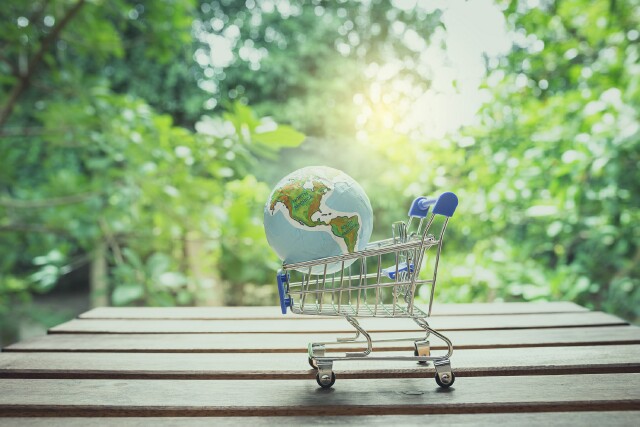Priming the Pump for Sustainable Retailing -- Publicis

Sustainability continues to not only be a major contributing factor to consumer purchasing behavior but a critical step towards lowering our carbon footprint for stabilizing planet-wide climate upheaval. There are many factors that go into retail sustainability, spanning the entire supply chain and every facet of production, from packaging to shipping to returns, all the way to the composition of physical and digital storefronts. Several retailers and direct-to-consumer (DTC) brands have emphasized various components of this as they pitch their wares to consumers, but far fewer have considered the entire ecosystem. As consumers become more vocal about where they spend their money, brands and retailers will inevitably need to focus efforts that emphasize their actions on environmental considerations as a core tenet of their business model.
Leading this movement in a holistically responsible manner are Target and Walmart, both of which are addressing shifting consumer expectations for big retail, demonstrating initiatives both physically and digitally.
For instance, as recently as early March, Target spearheaded a new digital storefront called Target Zero on its primary site. The concept is a curation of sustainable products the retailer sells, based on specific product criteria: reusable/refillable, reduced plastic, recycled content, waterless/concentrated, and/or compostable elements. As a driving part of this initiative Target has overhauled their ecommerce search and classification system to better accommodate product filtering for sustainable/ingredient considerations through Target Clean. And on the brick-and-mortar front, they’ve also equipped more than 500 of their stores with rooftop solar panels (to generate an annual energy surplus of 10%). This move is to replace natural gas with energy from solar panels specifically for its HVAC heating.
Walmart has built an extensive Sustainability Hub that organizes its initiative ecosystem. This is prominently tied into their retail website infrastructure, and details to business partners and customers alike its focus on a number of projects, including their pipeline for sustainable supply chain aims for everything from beef to coffee, and sustainable packaging approaches via system-wide overhauls. Additionally, the THESIS Index, an independent and data-driven solution, allows its brands and manufacturers to understand the planet-wide impact of their products and pivot to a clear explanation of their story to retailers, investors and consumers.
Walmart and Target have been riding (as well as leading) a long wave of important trends in this direction for years. In the early onset of consumer headspace for respect to sustainable efforts, outdoor enthusiast sites like Patagonia and REI were leaders in donating a percentage of sales to the preservation and restoration of the planet, and have since emphasized longevity of material goods sold through repair/recirculation programs like Worn Wear and Re/Supply.
In more recent years, we've seen a plethora of efforts across retailers and brands alike.
- Amazon made a stir more than a decade ago with their Frustration-Free Packaging initiative, where as of 2022 they've claimed to "reduce the weight of outbound packaging by 33% ... eliminating more than 900,000 tons of packaging material.”
- DTC retailers have built better native products both by distribution (packaging) and by constitution (ingredients), like Public Goods, a modern take on the co-op that sells private label goods using tree-free paper items and bioplastic containers, and emphasizing liquid product refills/reusability (similar to household cleaning collaborate, Grove).
- More industry-focused DTC brands, like clothing outfitter Ministry of Supply, have emphasized their sustainability initiatives in a whole section of their sites. Ministry of Supply even built a Carbon Neutral Playbook that is featured on TEDx.
- Even the biggest of brands, the two-trillion dollar company Apple, has set Carbon neutrality as a cornerstone for its operations, emphasizing the use of less power and recycled materials, leaning on environmental energy, and reducing packaging/accessory components.
The Takeaway
Businesses have and will continue to move in more sustainable directions. Communicating these initiatives will be an integral part of consumer awareness, intrinsically tied to running both physical and digital storefronts. Some key considerations:
- Environmental/Sustainability Website Sections. Prominently featuring a section of your website with sustainability initiatives, as well as environmental considerations and impact, is the most easily accessible way to log and update consumers and the media on initiatives and core competencies in this area.
- Product Detail Page Updates. Where appropriate, based on website design compositions and philosophies, notating sustainability or environmental attributes for products at the product-level webpage is a strong conveyance of taking earth-conscientious product inventory seriously.
- Impact Statements. Some brands are doing excellent work in transparently communicating supply chain journeys, costs and impact. While not every company can afford full transparency, sustainable efforts should be emphasized. A great, unobtrusive way to communicate this (apart from the product detail page) is in an e-mail receipt.
- In-Store Signage Reflecting Initiatives. Walk into a Target and it's hard not to glance at their prominent signage about a location's solar-powered rooftop (or, as I'm sure they'll promote, various other green initiatives). It's a signal to customers that Target is making an effort in this arena, and you are a part of it by shopping its stores. Think about ways of conveying this either on-site (physically) or throughout your digital storefront.
Either way you decide to start on this journey, or refine it, doing so incrementally is the key. We can't solve the climate crisis overnight, and you can't solve for all the nuances of a sustainability-friendly supply chain in day. This process takes time; chipping away at the lowest overhead efforts (typically like digital storefronts) can be a great way to pave forward right now and meet customers' expectations sooner rather than later.
Click the social buttons to share this content with your friends and colleagues.
The opinions and points of view expressed in this content are exclusively the views of the author and/or subject(s) and do not necessarily represent the views of MediaVillage.com/MyersBizNet, Inc. management or associated writers.


